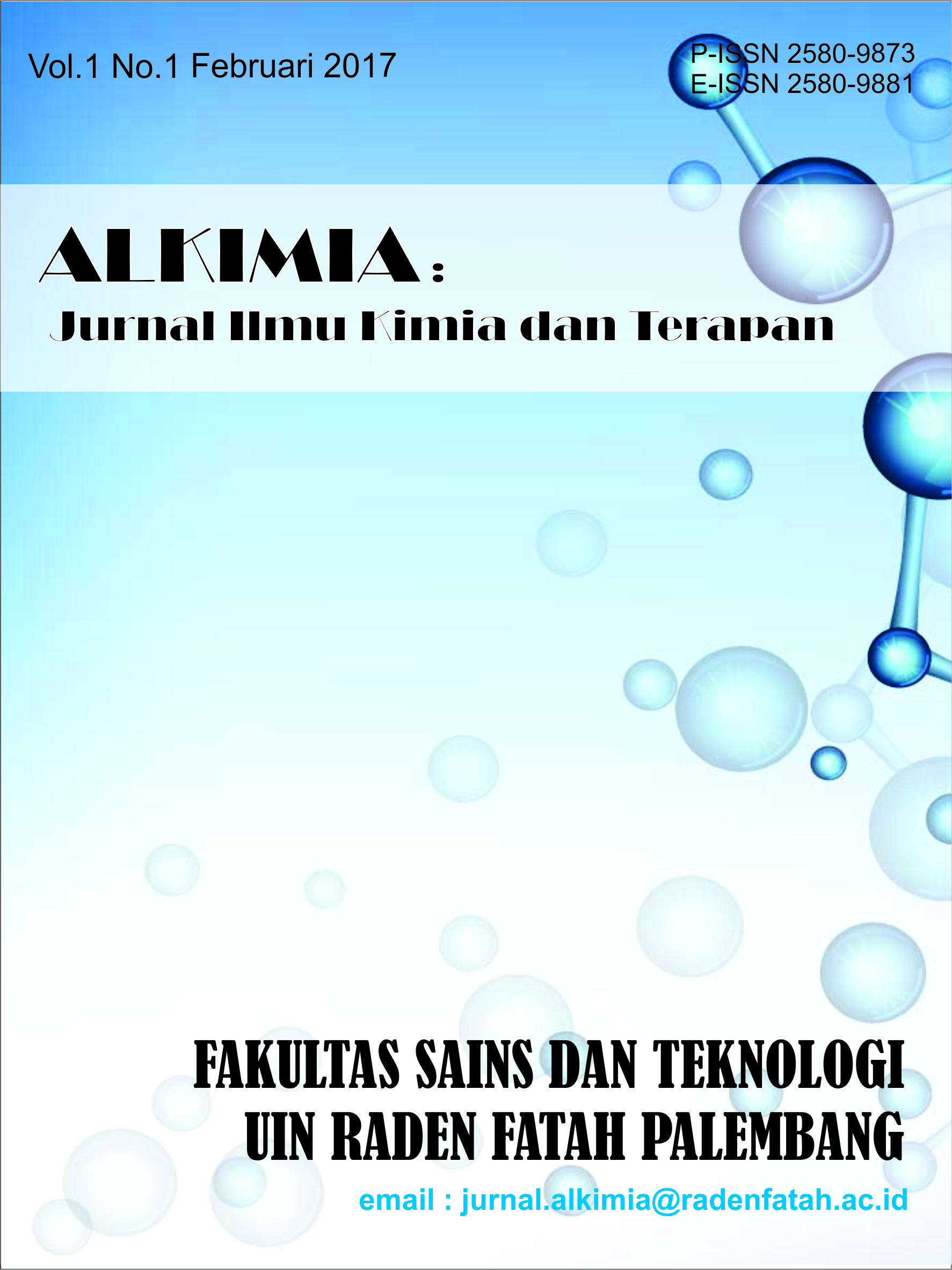Synthesis and Characterization of Vertosin Schiff Base with Temperature and Time Optimization
DOI:
https://doi.org/10.19109/5vbvn151Keywords:
Schiff base, vertosin, fragrance synthesis, condensation reaction, gas chromatography-mass spectrometryAbstract
Perfume is a product designed to mask or eliminate unpleasant odors and impart a pleasant fragrance to the body, rooms, or various objects. One synthetic ingredient commonly added to fragrances is a schiff base, a compound formed through a condensation reaction between an aldehyde and an amine. Schiff bases enhance the chemical and thermal stability of fragrances due to their distinctive and long-lasting aroma. One such compound, vertosin, is known for its strong green, citrus, and herbal scent and is suitable for personal care products. This research aimed to synthesize vertosin via a condensation reaction between triplal and methyl anthranilate under varying temperatures and durations, and to characterize the resulting product using Gas Chromatography-Mass Spectrometry (GCMS). The study employed a combination research method consisting of synthesis, characterization, and data analysis. The synthesis was conducted at temperatures of 90, 100, and 110°C for 30 and 60 minutes. Characterization included organoleptic tests (color and odor), density and specific gravity measurements, and compound confirmation using GCMS. Data analysis was performed using two-way ANOVA. The results showed that the optimal condition for vertosin synthesis was at 110°C for 60 minutes, yielding the highest concentration. Mass spectrometric fragmentation patterns confirmed the product as methyl 2-[[(E)-2,4-dimethyl-1-cyclohex-3-enylidene)methyl]amino]benzoate with a molecular weight of 271 g/mol. The synthesized vertosin had a green, lily, orange blossom, fruity, floral scent, an orange color, and average density and specific gravity values of 1.092 and 1.094, respectively, which were in accordance with standard specifications.
References
Iswara, F. P., Dwiarso, R., and Tatang, S. J., “Analisis Senyawa Berbahaya dalam Parfum dengan Kromatografi Gas-Spektrometri Massa Berdasarkan Material Safety Data Sheet (MSDS),” Indonesian Journal of Chemical Research, vol. 2, no. 1, pp. 18–27, 2014.
Rowe, D. Chemistry and Technology of Flavours and Fragrances, USA: Blackwell Publishing Ltd., 2005.
Wibowo, S., Candra, I., Dian, I., Rika, P. P., and Imalia, D. P., “Aurantiol Schiff base as A Raw Material in Fragrance Industry Synthesized by Simple Condensation Method and Its Characterization Using GC-MS,” Orient. J. Chem., vol. 36, no. 3, pp. 577–580, 2020.
Schmidt, C., “Schiff Bases – A Primer,” Perfumer & Flavorist, vol. 27, p. 32, 2002.
Yuliana, E., Candra, I., Dian, I., Singgih, W., Rika, P. P., and Imalia, D. P., “Synthesis and Spectral Characterization of Verdantiol Schiff base with GC-MS for Synthetic Ingredients in Fragrances Industry,” Orient. J. Chem., vol. 35, no. 6, pp. 1737–1741, 2019.
Utami, A., Candra, I., Dian, I., Rika, P. P., and Singgih, W., “Synthesis Study of Precursor Mixture of Verdantiol, Aurantiol and Lyrame Schiff Base and Its Characterization Using GC-MS,” Orient. J. Chem., vol. 35, no. 3, pp. 1244–1247, 2019.
Inamdar, A. “Vertosin,” Perfumer & Flavorist, 2009.
International Flavors & Fragrances Inc., Fragrance Ingredients: Triplal, Perfumer’s Compendium, p. 183, 2018.
Ventos, Spesification Sheet: Schiff Base, Triplal/Methyl Anthranilate, Ventos Spesification Sheet, no. 2, 2022.
Kuswandi, M., Bayu, A. Y., and Broto, S., “Aktualisasi Kimia dalam Pengelolaan Sumber Daya Alam Berwawasan Lingkungan pada Era Globalisasi,” in Seminar Nasional Kimia UNJANI-HKI, 2016, pp. 276–280.
Supriyono, Candra, I., Suci, I., Endang, S. L., and Arinzani, H. “Synthesis and Characterization of Aurantiol Schiff Base, Relationship Between Synthesis Time and Some Physical Properties,” Orient. J. Chem., vol. 34, no. 1, pp. 394–400, 2018.
Adesina, A. D., “Synthesis of schiff bases by non-conventional methods,” IntechOpen, 2022, DOI: 10.5772/intechopen.108688.
Irawan, C., Swatika, J., Hanafi, H., Henny, R., Miskah, Y. F. and Rika, P. P., “Synthesis and spectral characterization Schiff base cyclantine with GC-MS,” Int. J. Chem. Stud., vol. 5, no. 5, pp. 475–479, 2017.
Arctender, S., Perfume And Flavor Chemicals, 2nd ed., Montclair, N.J., U.S.A: Publisher Montclair, 1969.
Kristanti, R., “Pemanfaatan Minyak Atsiri Kapulaga (Amomun cardamom Willd), Kayu Manis (Cinnamon burmanni Ness), dan Jeruk Purut (Citrus hystrix DC) dalam pembuatan parfum,” Skripsi, Universitas Kristen Satya Wacana, Salatiga, 2015.
Arsa, M., “Proses Pencoklatan (Browning Process) pada Bahan Pangan,” Jurusan Kimia, Fakultas MIPA, Universitas Udayana, Denpasar, 2016.
Saputra, A. T., Muhammad, A. W., and Irsan, “Utilization of Used Oil for Biodisel Manufacturing Using Zeolite Activated Catalyst,” Jurnal Chemurgy, vol. 01, no. 2, pp. 1–6, 2017.
Darmapatni, K. A. G., Basori, A., and Suaniti, N. M., “Pengembangan Metode GC-MS untuk Penetapan Kadar Acetaminophen pada Spesimen Rambut Manusia,” Boisains Pascasarjana, vol. 18, no. 3, pp. 64–71, 2016.
Sakiah, S., “Modifikasi Proses Penyulingan dengan Variasi Tekanan Uap untuk Memperbaiki Karakteristik Aroma Minyak Pala,” Tesis, Sekolah Pascasarjana IPB, Bogor, 2006.
Downloads
Published
Issue
Section
License
Copyright (c) 2023 Revina Yuliastuti, Nurlela Nurlela, Devy Susanty, Nina Ariesta

This work is licensed under a Creative Commons Attribution-ShareAlike 4.0 International License.
- The author saves the copyright and gives the journal simultaneously with the license under Creative Commons Attribution License which permits other people to share the work by stating that it is firstly published in this journal.
- The author can post their work in an institutional repository or publish it in a book by by stating that it is firstly published in this journal.
- The author is allowed to post their work online (for instance, in an institutional repository or their own website) before and during the process of delivery. (see Open Access Effect).







.png)




